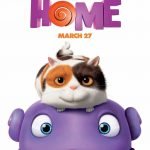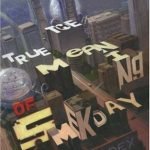Stepping Stones, A Refugee Family’s Journey by Margriet Ruurs
Stepping Stones, A Refugee Family’s Journey is a story from a Syrian girl’s perspective about having to flee her country.
Rama loved playing with her dolls and her brother Sami, going to school, drinking tea with her neighbours and buying produce at the market. Life was peaceful and fun in her Syrian village. But her grandfather, Jedo, complained that they were not free to sing their favourite songs, or dance, or to pray the prayers of their choice. Then a few neighbours started to leave. When bombs began to fall near her village, the birds didn’t sing, and there was not enough to eat. More people left, fellow villagers in search of a place where they could be safe from bombs and enjoy life. The day came when Jedo told her family they had to pack up and join the rest leaving their village, their pets, and their life in Syria. They walked for a long time, carrying blankets, food and clothing.
They finally came to the sea and boarded a boat with many others. The ocean tossed and punished their boat and some people didn’t make it. Prayers were said for those they had to leave at sea. When they landed, again they walked, but this time they walked without the fear of war. New friends helped them and gave them food and clothes, and a doll for Rama. She and her family were called the lucky ones, the ones with hopes and dreams of peace.
Pros:
- Margaret Ruurs has stayed away from politics, and has simply told a story from a child’s perspective. The child neither understands why the conflicts happen or when it will stop.
- The Syrian illustrator, Nizar Ali Badr, has achieved so much with so little. He gathers stones from the seashore where he lives and creates amazingly powerful and expressive illustrations that are truly inspiring.
- Children will love the details of the story, and feel for Rama who merely wants the security of having family and friends around and to live in peace.
- Terrible things happen, but they are written in such a way so as not to scare small children.
Cons:
- Frankly, I couldn’t think of a single thing to put here! I felt it was a powerful and moving story, and one that should be told.
My Personal Opinion:
As an artist, I was pulled into the story because of the sincere understated style and the expressive and sensitively portrayed figures. The fact that the illustrator is also a Syrian who used local materials in such an ingenious way was a bonus. I always appreciate artists who think and work outside of the box, and the illustrations in this book showed amazing imagination. I also loved the story from a child’s perspective. Being a parent, her plight hit home. Their predicament will also help children see how lucky they are to live where they live.
Discussion Questions:
- Before the war, how did Rama’s lifestyle compare to yours?
- Rama had to leave her home and bring very little with her. Have you ever been sad to leave a home? If so, what could you not leave behind?
- The illustrator did not draw or paint the pictures. How do they differ from most of the illustrations you have seen?
- Have you ever created pictures using something out of the ordinary? If so, what did you use?
- When Rama and her family landed in a new country, they had to learn a new language. Have you met or played with someone who either didn’t know English at all, or knew only a little? If so, were they shy and scared?
- If you know of someone who doesn’t know English, what are some ways to help them learn and to feel welcome?
Painting the Rainbow by Amy Gordon
Painting the Rainbow is a beautiful, multi-generational story of the Greenwood family’s summer reunion. The Greenwoods appear healthy, supportive of one another, ideal—except for the mystery of Jesse’s death more than twenty years earlier.
Thirteen-year-old Holly narrates, but a neat twist is added. Her cousin, Ivy, also thirteen, provides point-of-view through her diary entries. The girls stumble upon various clues about their Uncle Jesse’s past, but no one will discuss it. Ivy’s dad, Jesse’s twin, goes ballistic if Jesse’s name is mentioned, and even their beloved grandmother Gigi refuses to enlighten them.


Set in 1965 as the Vietnam War gears up, parallels between the generations become more and more focused, and the girls learn of an unusual connection between Uncle Jesse and a young Japanese man who came to their town shortly before World War II started.
Dozens of threads of the individual characters’ personalities and actions intertwine, and Amy Gordon weaves them skillfully into a sublime story tapestry—one I’ll read again.
And I rarely read a book twice.
Pros
1. The voice, the prose, the style—they all drew me in immediately. I didn’t want to put down the book. Forget lunch, dinner, housework, or writing tasks.
2. The story is a great vehicle to teach the issues of the 1960’s. We can see the results of those issues fifty years later.
3. Some books deal with dark subject matter and make me feel soiled by the end. Not with Painting the Rainbow. Every character, while containing a flaw, or two or three, is a realistic, valuable human being, and none of the flaws compromise a Christian reader’s values.
Cons
1. As per number three on my Pros list, the Greenwood family isn’t particularly Christian; however, they reflect moral values of the Golden Rule.
2. My own little pet peeve: the choice of Holly and Ivy for names of the main characters. Too cutesy of a combination!
Discussion questions
1. What were the repercussions of keeping a secret for twenty years?
2. How were the Japanese camps in America in 1942 similar to Nazi concentration camps? How were they different?
3. How was Jesse’s attitude toward war with Germany and Japan the same or different from Randy’s attitude toward the Vietnam War?
4. If you discovered a mystery about your family’s past, would you keep searching for answers like Holly did no matter if people got upset with you, or would you back off like Ivy wanted to?
Killing the Rising Sun
Killing The Rising Sun
Killing The Rising Sun is an excellent historical account of the Pacific theatre during WWII. While the other books in this series that have been reviewed, Killing Jesus and Killing Lincoln, have been rated as suitable for middle grade up. Like Killing Patton, Killing The Rising Sun should categorized as new adult because the book was not written for children.There is a bit more mature content in Killing the Rising Sun. There is some language and content that is not appropriate for younger and more sensitive readers. Along with this, the violence and graphic descriptions, especially with respect to the aftermath of Hiroshima and Nagasaki.
Pros
Killing the Rising Sun goes into detail about the end of WWII, particularly the Pacific theatre. General Douglas MacArthur, President Truman, the end of WWII, specifically the sinking of the Indianapolis, the siege on Okinawa, and dropping the atomic bombs on Hiroshima and Nagasaki are the focus. O’Reilly and Dugard go into great detail to put General Douglas MacArthur’s military career, particularly his role in the Pacific theatre.
The book focuses not only on General MacArthur but also President Truman and the difficult decision to drop the atomic bomb. The premise of the book is that the decision to drop the atomic bomb on Japan wasn’t an easy one but considered the option that would save the most lives of both the Allied soldiers and Japanese civilians. Robert Petkoff instead of Bill O’Reilly narrates the audio version of Killing the Rising Sun, and I highly recommend it. He is an excellent narrator and does a good job of including the footnotes to make them fit seamlessly into the text.
Cons
There are a few, which is why I categorized Killing the Rising Sun as New Adult. There are several colorful characters. With this there are some swear words, innuendo, coarse language, and discussion of extramarital affairs are discussed. While not graphic, this makes the content more mature. This is a book set during a long and bloody war that might bother some sensitive readers or listeners. Even compared to Killing Patton, Killing the Rising Sun is even more graphic. The damage from the atomic bombs is described. While not gratuitous, it doesn’t shy away from description. The same goes for the sinking of the Indianapolis and the siege of Okinawa.
Rating
4 Stars. Overall, Killing the Rising Sun is well-written and engaging. Like Killing Jesus and Killing Lincoln, the book rates 5 stars on the content and execution. New Adult allows for a bit more mature content, but even with this caveat, there is some coarse language and innuendo, even more than in Killing Patton. As with the other books in the series, the historical details are the highlight of this book. My husband and I listened to the audiobook. Robert Petkoff narrates and has an engaging voice. However, I suggest reading or listening to the book before deciding if it’s appropriate for your children, students, etc.
Personal Opinion
We have listened to all of the O’Reilly-Dugard “Killing” books, and this is the fourth in my series on these books because I think each of them offers fantastic insight into the social and political climate at the time. However, not all will carry 5-star ratings even though the writing quality and level of detail are the same. This is the first one that I would not call entirely family friendly due to some objectionable content cited above. There is some language that might be objectionable to some people. Battles, extramarital affairs, and the brutality of war are discussed. There is some innuendo/coarse language mostly in the context of quotes and correspondence.
Discussion points for parents & teachers:
- What did you know about Harry Truman? Did your opinion of him and his actions change after reading this book?
- What did you know about General MacArthur? Did your opinion of him and his actions change after reading this book?
- Did you learn something new about General MacArthur?
- Name some good things about General MacArthur?
- Name some of General MacArthur’s character flaws?
- Did you learn anything new about Hirhito?
- List some things about Imperial Japan that are different from the United States.
- Discuss the decision to use the atomic bomb.
Parents will appreciate the historical account of this time in history. For teachers and librarians there are so many great topics that can springboard from this book.
King’s Cage by Victoria Aveyard
Synopsis
Pros:
-
Victoria Aveyard has created a rich world full of conflict.
-
Mare’s character learns that pushing people away is a mistake. This makes her more likeable in King’s Cage.
Cons:
-
King’s Blood is not the end of the series. To some extent, it reads like a bridge novel.
-
The story contains other POV characters, such as Cameron and Evangeline. I enjoyed getting inside Evangeline’s head, but Cameron seemed an odd choice.
-
The author has an LGBTQ+ agenda that becomes evident in this book. One of the characters is a lesbian and there is a brief bedroom scene with her girlfriend. While not descriptive, it made my 12-year-old uncomfortable.
-
[spoiler alert] Mare and Cal begin a sexual relationship. When Farley is having her baby, she convinces the nurse to give Mare the equivalent of a morning-after pill.
Final Word
Discussion Questions
-
What kind of character is Maven? How did Maven’s mother contribute to making him into the King he becomes? Do you like him or not? Why?
-
What new things did we learn about Evangeline in King’s Cage? Do they make you like her more or less? Why?
-
How does Mare and Cal’s relationship evolve over the course of the series? How do you feel about it?
Amber The Story Of A Red Fox by Shirley Woods
Amber, The Story of a Red Fox, is a fascinating early chapter book that follows a red fox, from her birth to adulthood.
We are introduced to the parents, the playful young kits and their lives in the country as they dodge eagles, dogs, and learn lessons about porcupines and skunks.
By fall, Amber’s parents have left, and her brothers have gradually gone their separate ways. Amber still has much to learn. Driven by hunger and fear, she will use every instinct and intelligence she possesses to feed herself and stay safe.
She survives encounters with armed farmers, wolves, foothold traps, and one of the more lethal menaces, winter. But we rejoice when she finally pairs up with another fox that becomes her hunting partner and mate.
Pros:
- Shirley Woods educates us about foxes, without distracting the reader from her story. The facts happen naturally around the actions of the foxes, so we are happily immersed into their world.
- The story does not candy-coat nature. Animals die so others can eat and live. It is neither cruel nor sad, it just happens and life moves on.
- The main character, Amber, is a spunky little fox that learns quickly, and is a sure heroine for young readers.
- I thoroughly enjoyed the illustrations and felt that the style was very appropriate for the story.
Cons:
- The book is written in the third person omniscient POV, and I would rather have heard the story from Amber’s point of view only. I wasn’t a fan of the ‘head-hopping’ and would have felt closer to Amber if the story was from her perspective.
- With all the dangers that she encounters, Amber succeeds in never getting injured. Not even a little. I find that a bit hard to believe, and it belittles the threats she constantly faces. At the risk of sounding mean, I feel that if she suffered a bit more, the reader would sympathize with her more, and fear for her future.
My Personal Opinion:
I was drawn to this early chapter book as an illustrator, a writer for middle grade, and a lover of animals. It was a pretty easy sell, however, I was pleasantly surprised at the quality of the writing and the obvious research involved, and illustrations. Kids will love this story, as it seems there is danger around every corner, as there is in nature.
Questions For Discussion:
- What is the difference between a fox and a dog? (Hint-look at chapter 2)
- What were some of the lessons the kits (baby foxes) learned before they left their parents?
- What did Amber learn about surviving after she left her parents?
- How is the survival of foxes increased by having a partner?
Jane Eyre by Charlotte Brontë

Three weeks ago, I promised reviews based on my granddaughters’ favorite books. The oldest finally decided she loved Jane Eyre the best. She’s six, so she read the children’s version from the Treasury of Illustrated Classics. Voracious reader that she is, I give her four more years before she tackles Charlotte Brontë’s original text.
If you have never read Jane Eyre, Jane tells her story beginning as a young girl in a Cinderella-type of existence with her stepmother, stepbrother and stepsisters, none of whom have sympathy toward her. They send her to an orphanage claiming she is a terrible child, so the people who run the place don’t trust her either. Jane’s one friend, an older girl and a devout and kind Christian, dies of tuberculosis.
Once Jane grows up, she finds a position at Thornfield Hall as governess to Rochester’s ward, Adele. Thornfield Hall is an eccentric household but comfortable. Strange laughter from the attic is explained as “Grace Poole, one of the servants, who just goes up there to sew.” When Rochester and Jane fall in love and plan a wedding, a stranger enters the church in the middle of the ceremony declaring Rochester is already married. Jane runs away. If you want to find out the ending, read the book. I don’t want to spoil it!
Pros
- Children love to read about other children in precarious situations, and Jane Eyre delivers, as orphaned Jane endures many hardships through childhood and must make her way in the world as a young adult.
- Children, girls especially, love a good love story, and once again, Jane Eyre delivers. Her love story seems star-crossed, but just when all is lost, Brontë writes a happy ending employing unusual circumstances.
- Parents who want their children to appreciate literature will find this story and many other Treasury titles a wonderful way to introduce the classics.
- Jane’s character perseveres in every circumstance. She is not perfect, neither in beauty nor in temperament, but she never gives up on worthwhile goals, a quality I tried to instill in my own children.
Cons
- As an adult, I admit disappointment in the truncation of plot. But this is a review for kids’ satisfaction in reading, so I guess it’s not so much of a negative.
- With all the craze for fantasy and fairy princesses, Jane Eyre will not satisfy. But then, I have always promoted variety in the literary diet, so again, not much of a negative.
Discussion Questions
- If you had been another child at the orphanage, how would you have treated Jane?
- What would you have thought of Mr. Brocklehurst?
- Was it right or wrong for Rochester to lie about his crazy wife who lived on the top floor?
Conclusion
Modern Publishing has three dozen classic titles under the Treasury of Illustrated Classics logo, all of which boil down the plots to a third/fourth grade vocabulary. Of course, the nuances in the adult versions are missing, but the adaptations remain true to story. In this case, credit goes to Sara Thomson.
It’s Complicated by Laura L. Smith
It’s Complicated by Laura L. Smith is the first book in the Status Updates series, suitable for ages sixteen and up.
The series follows the stories of Claire, Hannah, Palmer, and Kat, college roommates, as they go through their freshman year. I would place this book on both the Young Adult and New Adult shelves because the protagonists are all eighteen years old at the beginning and grow older as the series progresses.
Pros:
- Ms. Smith deftly portrays four very different girls as they tell their stories–both individual and collective–in their own words. The author tackles some difficult topics in a realistic manner, but she manages to keep the story hopeful and inspiring.
- It’s Complicated introduces the main characters during the end of their summer and first weeks of school. The four friends learn to pull together as they navigate through life-changing circumstances.
- Young Adult readers will relate to the dilemmas and decisions the main characters face. Drama and trauma are interwoven with funny and embarrassing moments Readers will definitely want to tune back in for the remaining four books in the Status Updates series to find out what happens to Claire, Hannah, Palmer, and Kat.
- Due to a couple of adult situations, this material is inappropriate for younger students. However, the Lexile is approximately 610L based on a sample, so struggling readers will not have a problem enjoying the text.
- All of the girls claim to be Christian. Kat’s family has moved several times, so they’ve “switched churches a lot.” Claire keeps her Bible and a journal beneath her pillow. She says she attends church back home.
- Palmer admits to being a Christian and always wears a silver cross necklace. It bothers her that her boyfriend’s family doesn’t pray before meals. Claire is convinced that she’s too dirty for God to love after the assault; I found this crisis of faith to be realistic.
Cons: (spoilers)
- Claire’s date lures her to his room and rapes her. The attack, told from Claire’s point of view, is short and not graphic, although she leaves no doubt about what has happened to her.
- Palmer’s long-term high school boyfriend pressures her to have sex with him to prove that she loves him. She resists, but not before it’s almost too late. Their physical relationship has spiraled out of control, and he cannot keep his hands off her. She, in turn, lets passion cloud her judgement.
- Kat makes out with a guy she knows isn’t the sort of boy she can take home to meet the parents.
- Claire’s mom discovers that her serious boyfriend is already married. Claire is pressured to drink wine on at least two occasions while in France, even though she’s underage in the United States. She drinks too much the last time, and this makes her vulnerable to the assault mentioned above. Claire cannot seem to catch a break.
- Kat’s new friend and fellow soccer player uses “K2,” a synthetic form of marijuana, to relax and deal with stress. He compares it to drinking wine. She refuses his offer to share.
- A random stranger offers to buy Palmer a beer.
- Claire’s father walked out on her mother when Claire was seven. Claire’s mother goes from one relationship to another. This distorts Claire’s perspective on men.
- Kat decides to get a stud in her nose without her parents’ consent. She knows her mother won’t approve.
- Palmer’s mother seems overly concerned about appearances, nagging Palmer about staying trim.
My Personal Opinions:
Mature adult readers who–like me–frequently read YA fiction may find the style too telling. These accounts read like a girl’s diary. That’s fine, up to a point, but the constant emotional input from the four girls, revealing their feelings through “I feel” and “I felt” statements exhausted me.
That said, Laura L. Smith hits the sweet spot for her intended audience of young women on the threshold of life. This is an inspirational novel that fits neatly under the heading of Christian contemporary YA fiction.
In this book, there is no overt “altar call” as is found in some inspirational fiction. This is the way Christian fiction should be written, keeping things real and addressing the difficult questions we face.
For Young Adult/New Adult readers, It’s Complicated will too soon, and they will want to pick up each new installment as soon as it’s available.
The True Meaning of Smekday by Adam Rex
The True Meaning of Smekday and its sequel Smek for President are comedic science fiction romps for middle school students. These are the books that inspired the animated movie Home, which is a family favorite. If you haven’t seen it, you should.
Synopsis
The Smek books follow the adventures of Gratuity Tucci, her cat Pig, and an alien name J.Lo, whose species has taken over planet Earth and kidnapped Tip’s mom. The first book is set on Earth, the second on another planet.
Pros:
- While the Smek books are the basis for the movie, that’s all they are. The stories quickly diverge from the movie so the readers can be surprised by what’s coming. The characters are similar enough that you feel like you’re reading companion novels.
- The book is fun and funny. The antics of J.Lo are sure to make you smile.
- The book is written in the format of a school assignment, so children will identify with the personal essay form.
- Boys and girls should both enjoy the book.
Cons:
- While I enjoyed both books, I didn’t like the mom-character in the book at first. (She gets better).
- I must admit that I liked the movie version of the story better, but the books are still worth reading.
Final Word
Recommended for a fun read. Definitely a series of the home (or school) library.
Discussion Questions
- While the movie Home and the book The True Meaning of Smekday started similarly, the stories themselves ended up going in different directions. What did you like better about the movie? What did you like better about the book?
- If a catastrophe separated you from your family, what would you do? Who would you go to for help?
- What did you think was the funniest part of the book?
- Who was your favorite character, and why?
Ed’s Egg, by David Bedford and Karen Sapp: A Picture Book Worth Reading Over and Over
While Scriblerians focus almost exclusively on middle grade and YA fiction, the occasional picture book review adds some extra fun, especially if a personal story is attached.
I’ve been on “Baby Watch” for all of February. Three little granddaughters are waiting for their baby brother’s arrival. In the middle of the month, I received The Call.
“She’s had contractions all day,” my son informed me. “You’d better start driving.”
Since I live five hours away, this has worked well for the three previous births. However, once I arrived, the latest news was disappointing. Everything had stopped. No more labor. Baby Samaritoni was not interested in joining the rest of the family. Not yet. His decision left ample time to play with his sisters. Ample, as in days, not hours.
I decided to ask my granddaughters to name their favorite books, and I would do my next two posts on their choices. The oldest is a voracious reader. She couldn’t decide what her favorite story was, but her sister next in line immediately handed me her choice.
Ed’s Egg by David Bedford and Karen Sapp. What a delightful picture book.
Ed is a little chick who doesn’t want to hatch. (Can you see the connection with my own family drama?) He’s gotten too big for his egg, so it cracks in more and more places, but he still won’t leave the shell until it finally leaves him.
Once Ed is forced to walk around without his egg, he discovers it’s more fun to play with his brothers and sisters than to stay squashed inside an egg. And when he gets tired, the best place of all is to be tucked safe and warm under his mother.
Of course, small children love the aura of mother love and family fun, and the illustrations contain detailed textures vibrating with color, sure to capture a toddler’s attention.
For older children, the author provides several discussion questions which utilize language skills, science, expressing feelings, and art. Explaining how a mother hen must incubate her eggs. Asking for children’s reactions when they feel shy and want to hide.
The author question we’ve been asking in our family: why do you think Ed didn’t want to come out of his egg?

Ed’s Egg has a happy ending, and our story does, too. Baby brother was born on February 22nd, healthy and heavy–and just like Ed, his happiest place to be is tucked close against his mommy.













